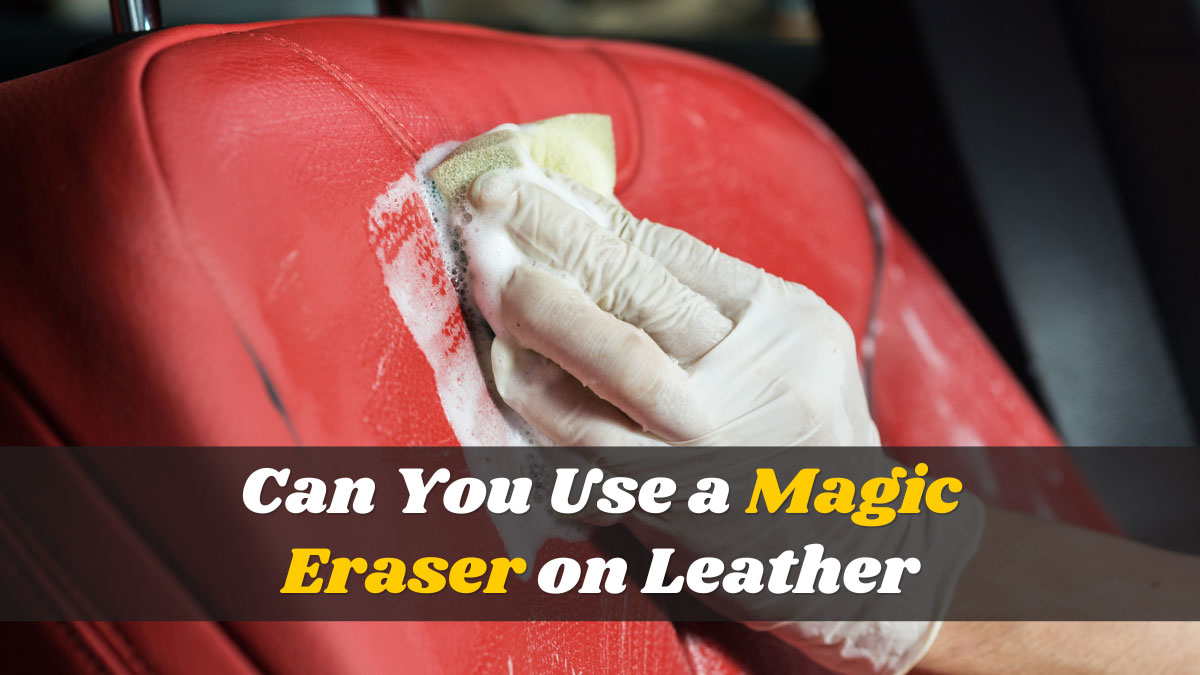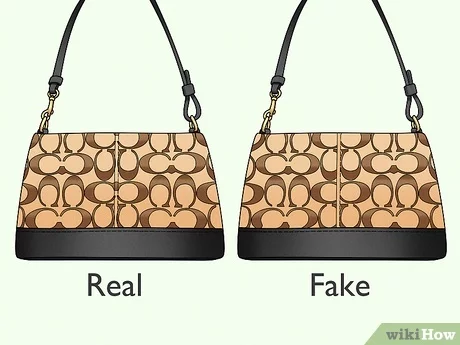Can You Use a Magic Eraser on Leather: Tips and Risks
When dealing with pesky stains on leather, you might wonder if a magic eraser is the solution you need. Known for their versatility in tackling tough spots, magic erasers seem like a tempting option. But, their abrasive nature raises concerns, especially when it comes to delicate materials like leather.
Using a magic eraser on leather can be a double-edged sword. While it might remove stubborn blemishes, it can also strip away the leather’s natural patina and finish. Some users have found it effective for specific issues, like mold spots on vintage bags, but caution is key. You must exercise a gentle touch to avoid damaging the surface.
Before you reach for that magic eraser, it’s crucial to weigh the potential risks and benefits. Understanding how to use this tool properly can make all the difference in preserving your leather items’ beauty and longevity.
Key Takeaways
- Understanding Magic Erasers: Magic Erasers are made from melamine resin and function like fine sandpaper, which can pose significant risks to delicate materials like leather due to their abrasive nature.
- Risks for Leather: Using a Magic Eraser can strip away protective coatings and dye from leather, causing discoloration, scratches, and inconsistent surface colors.
- Potential Benefits: While they can swiftly remove tough stains, the abrasiveness of Magic Erasers might lead to surface damage, necessitating caution.
- Preparation is Key: Before using, test the Magic Eraser on an inconspicuous area, gather necessary supplies, and prepare to condition the leather afterward to prevent damage.
- Safer Alternatives: Opt for pH-balanced leather cleaners and soft-bristled brushes for non-abrasive cleaning, ensuring the maintenance of leather’s natural beauty and longevity.
Understanding Magic Erasers
Magic Erasers are tools made from melamine resin that resemble very fine sandpaper. They’re known for their ability to tackle stubborn stains and marks on a variety of surfaces. But, their high abrasive nature poses significant risks when applied to delicate materials like leather.
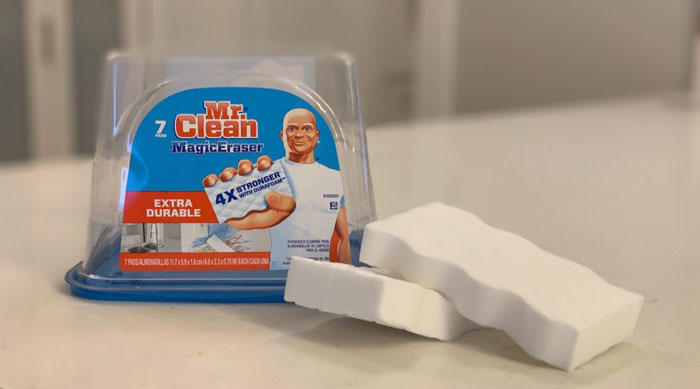
Composition and Functionality
- Melamine Resin: Magic Erasers are composed of this material, which performs like delicate sandpaper, effectively removing dirt and grime.
- Surface Impact: The erasers work by gradually sanding down surface layers, which explains their effectiveness on tough, non-delicate surfaces.
Risks on Leather
- Abrasive Action: On leather, this abrasive nature can remove protective coatings and dyes, leading to discoloration and surface deterioration.
- Potential Damage: Using a Magic Eraser may result in scratches and inconsistent leather color due to the removal of finishes.
- Consider the quality of the leather since not all leathers, even if advertised as such, possess the same robustness. Newer vehicle leather often has lower-quality dyes and coatings, making them more susceptible to damage.
- Evaluate if restoration is planned since using Magic Erasers is more acceptable when you intend to reapply finishes.
Recognizing these elements can ensure the proper use of Magic Erasers, minimizing risks and preserving the longevity and appearance of leather items.
Effects of Magic Erasers on Leather
Magic Erasers can be both helpful and harmful when used on leather surfaces. While they offer quick cleaning results, their abrasive nature poses significant risks to leather’s appearance and integrity.
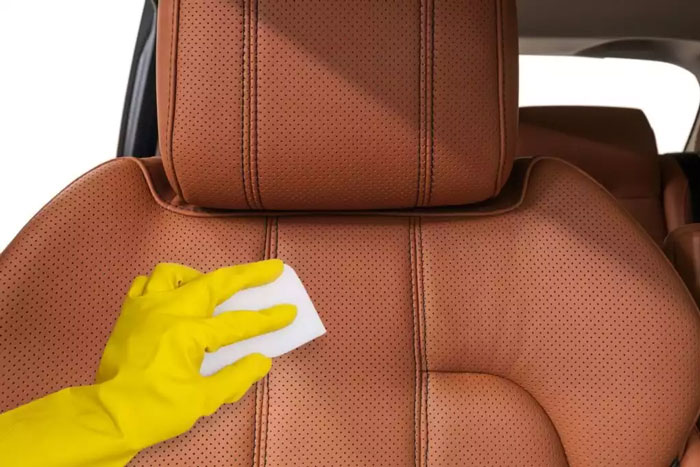
Potential Benefits
- Stain Removal: Magic Erasers can effectively remove stubborn stains, dirt, and marks from leather by using fine, abrasive fibers similar to sandpaper. This makes them appealing for situations where swift action is needed to address difficult stains.
- Quick Results: Their structure enables the erasers to deliver prompt, visible outcomes, which can be advantageous in addressing immediate and pressing cleaning demands.
- Surface Damage: The abrasive fibers in Magic Erasers might wear away the protective coating on the leather surface, revealing underlying layers. This could lead to scratches and deterioration of the leather’s natural finish, such as discoloration and scuff marks.
- Color Alteration: Using the eraser may lead to uneven color removal, especially on finished or coated leathers. This means that the use of Magic Erasers can result in a patchy or inconsistent appearance.
- Long-term Consequences: The erasers’ action can compromise the long-term durability of leather items, making them more susceptible to damage over time. If you plan to restore leather with new finishes, the risk might be minimized, but caution is crucial in other scenarios.
Understanding these factors helps maintain the beauty and longevity of your leather items, allowing for well-informed choice-making on cleaning methods.
Preparing Your Leather Item
Before you use a Magic Eraser on leather, understanding the risks is essential. These erasers, composed of melamine resin, act similarly to fine sandpaper and can harm your leather’s surface.
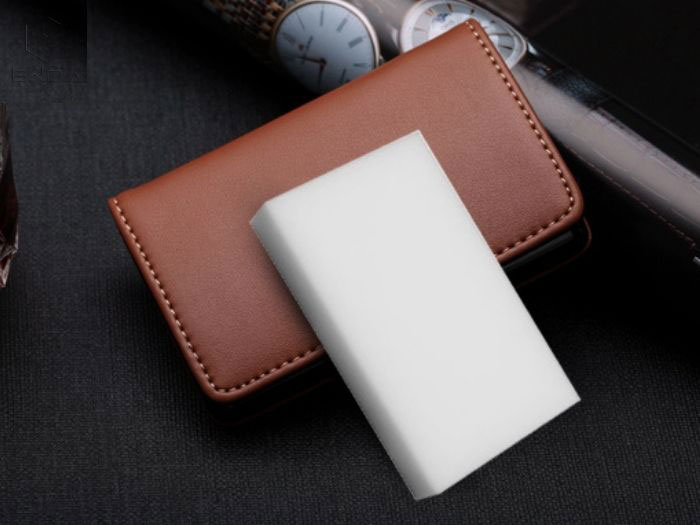
Testing on an Inconspicuous Area
Testing on an inconspicuous area helps assess your leather’s reaction to the Magic Eraser. Follow these steps:
- Select a Test Spot: Choose a small, hidden section of the leather.
- Apply Gently: Lightly rub the Magic Eraser on this spot.
- Observe: Check for any changes, like discoloration or surface damage.
By observing outcomes on a non-visible area, you prevent visible damage to your leather.
Gathering Necessary Supplies
Gathering the right supplies ensures you’re prepared for the cleaning process:
- Magic Eraser: Use a small piece to maintain control.
- Leather Conditioner: Rehydrate the leather after cleaning.
- Soft Cloth: Buff the area to restore shine.
- Water: Dampen the Magic Eraser lightly if needed.
Having these tools ready helps you execute the process efficiently and safely.
Steps for Using a Magic Eraser on Leather
Using a magic eraser on leather requires caution to prevent damage. Magic erasers are abrasive and can remove protective coatings.
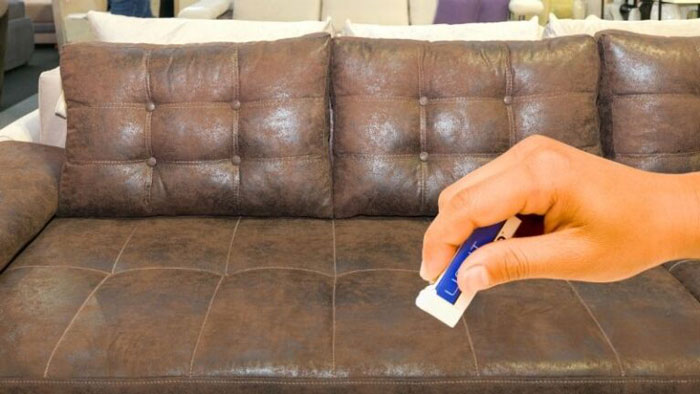
Gently Applying the Eraser
- Select a Test Area: Choose a small, inconspicuous spot on your leather item.
- Moisten the Eraser: Wet the magic eraser and squeeze out excess water to reduce abrasiveness.
- Apply Light Pressure: Use gentle, circular motions to avoid damaging the surface.
- Monitor Changes: Frequently check the spot for discoloration or surface wear.
- Clean Residue: After using the eraser, wipe the area with a clean, damp cloth to remove debris.
- Apply Leather Conditioner: Use a recommended leather conditioner to restore moisture and protect the surface.
- Repeat as Necessary: If the stain persists, repeat the erasing process cautiously. Re-condition the leather afterward to maintain its integrity.
Alternatives to Magic Erasers for Leather
Using a magic eraser on leather can lead to unwanted damage, making it crucial to explore safer alternatives. Opting for of pH balanced leather cleaners and brushes provides effective, non-abrasive cleaning options.
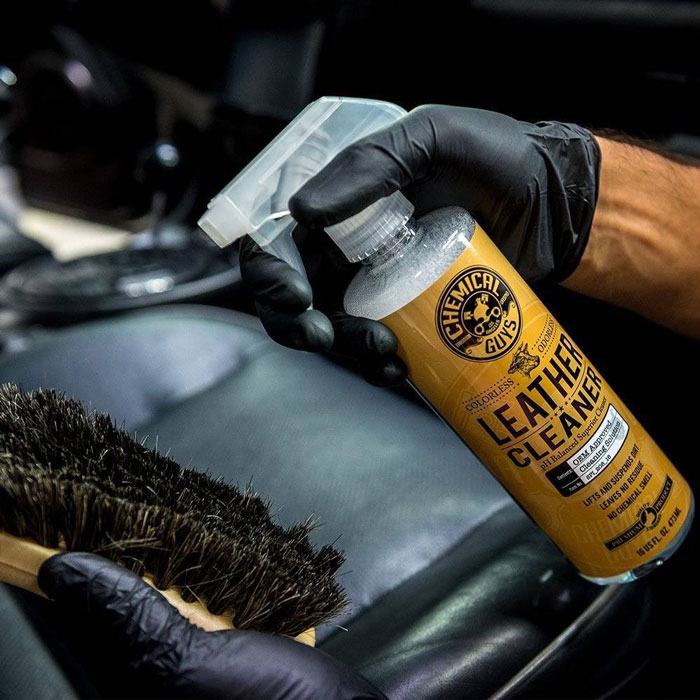
pH Balanced Leather Cleaners
A pH balanced leather cleaner is designed to clean leather surfaces without harming them. These cleaners maintain the integrity of leather by preserving its natural oils and avoiding discoloration. When using these products:
- Select a cleaner specifically labeled as pH balanced for leather.
- Apply a small amount on a soft, clean cloth.
- Gently wipe the leather surface in circular motions.
- Ensure the surface is free of residue with a damp cloth after cleaning.
Leather Brushes
Combining leather brushes with pH balanced cleaners offers a gentle yet effective cleaning method. A leather brush helps remove dirt and debris without causing abrasion:
- Choose a brush with soft bristles suitable for your leather type.
- Dampen the brush slightly if needed for thicker buildup.
- Use light, consistent pressure in a circular pattern.
- Clean the brush after each use to prevent abrasive particles from accumulating.
These alternatives maintain leather’s appearance and lifespan, making them ideal for regular care and maintenance.
Conclusion
When it comes to using a magic eraser on leather, understanding the balance between benefits and risks is crucial. While magic erasers can tackle tough stains, their abrasive nature demands caution. Testing on a hidden spot and using gentle techniques are essential steps to protect your leather items. Always consider the leather’s quality and whether restoration is planned before proceeding. Exploring safer alternatives like pH balanced leather cleaners can offer effective results without compromising the material. By making informed choices, you can ensure your leather remains beautiful and durable for years to come.
Frequently Asked Questions
Can a magic eraser damage leather?
Yes, a magic eraser can damage leather. Its abrasive nature can strip away protective coatings and finish, leading to discoloration and surface deterioration. It is essential to use it cautiously.
Is it safe to use a magic eraser on leather bags?
Using a magic eraser on leather bags can be risky. Test it on a hidden spot first to check for damage. While it may remove stains, it could harm the leather’s surface and color.
How should you prepare leather before using a magic eraser?
Before using a magic eraser on leather, test it on an inconspicuous area. Use gentle, circular motions with minimal pressure. Gather a leather conditioner, soft cloth, and water to clean and restore the leather.
What are alternatives to using a magic eraser on leather?
Alternatives to using magic erasers include pH balanced leather cleaners and soft brushes. These options clean effectively without abrasion, maintaining the leather’s natural oils and appearance.
Are magic erasers effective on all types of leather?
Magic erasers are not effective on all types of leather. They may cause more harm than good on delicate or newer vehicle leather. Consider the leather’s quality and if restoration is possible before use.

